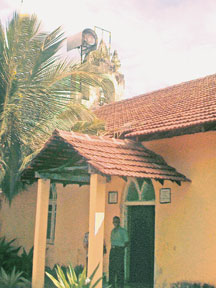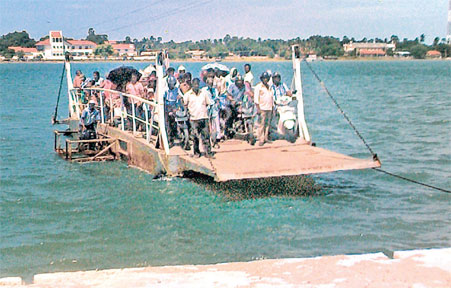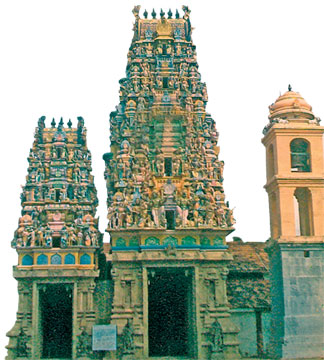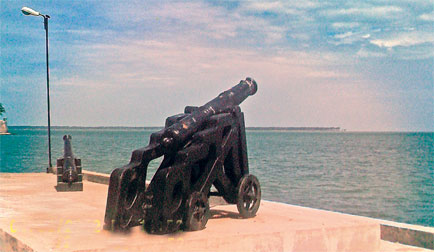An old world city: Captivating Karainagar
by Dishan Joseph
|

Church of CACM |
There is a resplendent island in the north of Sri Lanka, about 20 km
from Jaffna, a peaceful, yet arid paradise. Karainagar (Island of Karai
trees) is a destination that effortlessly combines the majesty of the
ocean, the splendour of old churches and kovils and a myriad of
succulent seafood. As we drive along the causeway that connects the
island to the mainland we see green nets on either side of the road,
where fishermen wade waist deep in the emerald green water and take in
an assortment of fish.
As we near Vallanthalai, one of the first quiet towns, the Northern
sun is receding. The strong aroma of fish permeates the air as the local
market has drawn her citizens for the day's catch. There is much
bargaining, cycles pass by. The bicycle is the most reliable source of
transport here and everyone has one.
The houses in Karainagar are built to blend with the natural
environment. Trees are retained in the construction process as they
offer shade. The daily routine of the people here is all about simply
coexisting alongside nature. A refreshing well bath is most welcome. The
deep wells produce water that has a mild flavour of lime, and amazingly,
many species of plants have adapted to this water. The sea breeze gently
drifts into the homes, where windows remain open as there is no threat
of theft.
Even though gates are closed, they are not locked. It is a classic
example of perfect social integration as people have lived in harmony
for generations and know each other.
 I wake up next morning to the crowing of the roosters. My kind host
proudly announces that he is going to serve one of these birds for
lunch. I feel mildly embarrassed that my presence has warranted the
death of a majestic foul. Even as the sun's radiant rays begin to paint
the morning sky, my friend has skillfully cut and dressed the rooster.
After breakfast, we head towards our first stop, the 160-year-old church
belonging to the CACM (Church of American Ceylon Mission). I wake up next morning to the crowing of the roosters. My kind host
proudly announces that he is going to serve one of these birds for
lunch. I feel mildly embarrassed that my presence has warranted the
death of a majestic foul. Even as the sun's radiant rays begin to paint
the morning sky, my friend has skillfully cut and dressed the rooster.
After breakfast, we head towards our first stop, the 160-year-old church
belonging to the CACM (Church of American Ceylon Mission).
Sailed
The CACM has been active in the Northern Province for centuries. Bold
and dedicated missionaries had sailed thousands of miles to come and
establish schools and hospitals in these parts. During those bygone
times they taught English and other social skills to the humble island
folk. The church built in 1855, today stands in much neglect, with its
bell covered in rust. I was surprised when the gate was opened by a
foreign lady priest! Rev. Susan Jepsen, a resident of Boston has been
here for the past two years. The church key is an antique. The top of
the key has a brass design where one can insert three fingers for a good
grip. A few feet away is a large manmade pond with steps leading
downwards, similar to the ponds found in the temples of Varanasi.
A few hundred yards away the Gopuram (tower) of the Sivan Kovil
reaches out to the clouds. The temple is a riot of colour as murals
adorn its walls, and two rock statues of Hindu deity stand defiantly at
the entrance. An old, bare bodied priest is offering incense within the
inner chamber of this sanctum, while a herd of goats has sought solace
in the large garden.
 We proceed from here to the jetty. Karainagar is also home to a naval
garrison. The sailors of SLN Elara are a part of this community. From
the jetty, I see the old Fort, rising out of the blue waters. Originally
built by the Portuguese it was named Fortaleza Real (Fort Royal). After
the Dutch invasion it was renamed as Fort Hammenhiel. The Fort had a
prison with 9 large dungeons. Today, the restored Fort is operated as a
luxury accommodation by the Navy. Three old canons stand like a silent
sentinel looking towards the horizon. As we wait patiently for the ferry
to arrive, a group of old men are seen smoking rolled dry tobacco
leaves, indeed a primitive cigarette. The ferry arrives, which connects
Karainagar to the island of Kayts. The ferry ride takes only 10 minutes.
The sturdy iron boat can even carry motorbikes, three wheelers and a
tractor! Many schoolchildren are dependent on this seaborne ride to get
to school. We proceed from here to the jetty. Karainagar is also home to a naval
garrison. The sailors of SLN Elara are a part of this community. From
the jetty, I see the old Fort, rising out of the blue waters. Originally
built by the Portuguese it was named Fortaleza Real (Fort Royal). After
the Dutch invasion it was renamed as Fort Hammenhiel. The Fort had a
prison with 9 large dungeons. Today, the restored Fort is operated as a
luxury accommodation by the Navy. Three old canons stand like a silent
sentinel looking towards the horizon. As we wait patiently for the ferry
to arrive, a group of old men are seen smoking rolled dry tobacco
leaves, indeed a primitive cigarette. The ferry arrives, which connects
Karainagar to the island of Kayts. The ferry ride takes only 10 minutes.
The sturdy iron boat can even carry motorbikes, three wheelers and a
tractor! Many schoolchildren are dependent on this seaborne ride to get
to school.
The island of Katys is like a page from a travel magazine. Two Naval
sentries smile as we pass by, and a row of shops display ancient wooden
doors, with carved trellice work on the topmost part. The Tamil name
boards have been painted by a steady artistic hand. Old lamps are
suspended on the wooden ceiling.
There are two old churches here, a church dedicated to St.James and a
shrine to honor St.Anthony. A small shop sells products based on
palmyrah. The palmyrah tree has become a symbol of resilient hope for
these people. There is much room for improvement to market and sell
these items, which can be transformed into a productive cottage
industry, as the women folk of both islands have very limited employment
in other trades.
Sight
We return to Karainagar, and as we travel by road I pick up the
distant silhouette of a large bullock cart. The sight of the cart is so
lovely, a sight you can never witness in Colombo. Two large bulls have
been yoked together, and a man rides with much pomp sporting a white
moustache, and grins at me displaying betel stained teeth. Another well
bath precedes lunch, as the departed rooster lay immersed in a bed of
curry. Dessert is mothakam, a steamed dumpling filled with grated
coconut, green gram and jaggery. It goes down well with a cup of coffee
infused with coriander. That evening, we visit an old eating house named
'Sellamuthu Suvayagam' (suvayagam is the Tamil word for a café). We
inquire from the well nourished cashier if we can buy paal appam
(hoppers laden with sweetened coconut milk). He requests us to come the
next morning by 6am.
 As we head towards the café in the morning, I see a convoy of
bicycles. The citizens of Vallanthalai are going to fill their larger
gallons with drinking water, which is a precious resource on the island.
Steps must be taken by the authorities to ensure that drinking water is
available to every home. It would then be a testament to sustainable
development. Mineral water bottles are sold to outsiders as Kolumbu
thanni (water from Colombo). We encounter more cycles as teachers and
students cycle to school, which I believe keeps them very fit. The
entire town is in a sense connected to the Post Office which serves as
an information hub. We go in search of dried fish, but the only two
shops that sell this local relish are closed for the day. Towards
evening, I witness older men walking in groups, and am told they are
going in search of toddy, a local delight that invigorates these hard
working souls. Karainagar is indeed an enchanting and serene island. As we head towards the café in the morning, I see a convoy of
bicycles. The citizens of Vallanthalai are going to fill their larger
gallons with drinking water, which is a precious resource on the island.
Steps must be taken by the authorities to ensure that drinking water is
available to every home. It would then be a testament to sustainable
development. Mineral water bottles are sold to outsiders as Kolumbu
thanni (water from Colombo). We encounter more cycles as teachers and
students cycle to school, which I believe keeps them very fit. The
entire town is in a sense connected to the Post Office which serves as
an information hub. We go in search of dried fish, but the only two
shops that sell this local relish are closed for the day. Towards
evening, I witness older men walking in groups, and am told they are
going in search of toddy, a local delight that invigorates these hard
working souls. Karainagar is indeed an enchanting and serene island.
(The writer wishes to thank Vincent Rajkumar of
Karainagar Post Office for accompanying him on his travel throughout the
island) |

